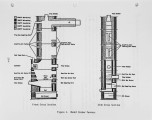| Title |
Control of Pollutant Emissions from Coal and Wood Combustion in Spreader-Stoker Systems |
| Creator |
Munro, J. M.; Bradshaw, F. W.; Pershing, D. W. |
| Publisher |
University of Utah |
| Date |
1982 |
| Spatial Coverage |
presented at Newport Beach, California |
| Abstract |
Stoker-fired boilers and furnaces are significant in terms of both solid fuel utilization and environmental impact; however, they have received relatively little research attention. The purpose of this investigation was to study the formation and control of nitrogen oxides and particulates in spreader-stoker combustion of bituminous coal and hogged wood. The study focused on optimizing the combustion conditions in each of the two distinct combustion zones, the bed phase and the suspension phase. The experimental work was carried out in a 750,000 Btu/hr laboratoryscale model stoker furnace. Local oxygen availability was found to be the controlling parameter for nitric oxide (NO) formation in each stage. Minimum NO emissions were found when local stoichiometric ratios were held at 0.70 - 0.85; reductions in NO emissions under these conditions were as much as 39 and 55 percent for wood and coal firing, respectively. Two control technologies for reducing pollutant emissions were investigated: Removal of the fines in the stoker feed, and optimizing the interaction between the bed and suspension phases through stoichiometry control. Fines removal during coal firing with, an excess-air bed resulted in a 20 percent reduction in NO emissions and an 81 percent reduction in particulate emissions. Stoichiometry optimization produced reductions in NO emissions of 4Q percent and 60 percent for excess-air beds and fuel-rich beds, respectively. Particulate emissions were reduced by 60 percent when the fuel bed was staged due to lower suspension-zone velocities. |
| Type |
Text |
| Format |
application/pdf |
| Language |
eng |
| Rights |
This material may be protected by copyright. Permission required for use in any form. For further information please contact the American Flame Research Committee. |
| Conversion Specifications |
Original scanned with Canon EOS-1Ds Mark II, 16.7 megapixel digital camera and saved as 400 ppi uncompressed TIFF, 16 bit depth. |
| Scanning Technician |
Cliodhna Davis |
| ARK |
ark:/87278/s6mw2kq8 |
| Setname |
uu_afrc |
| ID |
3467 |
| Reference URL |
https://collections.lib.utah.edu/ark:/87278/s6mw2kq8 |
























